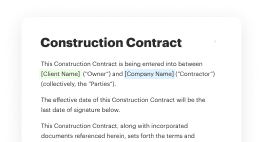Ensure Compliance with Online Signature Legality for Sick Leave Policy
- Quick to start
- Easy-to-use
- 24/7 support
Simplified document journeys for small teams and individuals




We spread the word about digital transformation
Why choose airSlate SignNow
-
Free 7-day trial. Choose the plan you need and try it risk-free.
-
Honest pricing for full-featured plans. airSlate SignNow offers subscription plans with no overages or hidden fees at renewal.
-
Enterprise-grade security. airSlate SignNow helps you comply with global security standards.







Your complete how-to guide - online signature legality for sick leave policy
Online Signature Legality for Sick Leave Policy
When it comes to managing sick leave policies and obtaining signatures online, airSlate SignNow provides a reliable and efficient solution. The process ensures legal validity and ease of use for businesses of all sizes.
Step-by-step Guide:
- Launch the airSlate SignNow web page in your browser.
- Sign up for a free trial or log in.
- Upload a document you want to sign or send for signing.
- If you're going to reuse your document later, turn it into a template.
- Open your file and make edits: add fillable fields or insert information.
- Sign your document and add signature fields for the recipients.
- Click Continue to set up and send an eSignature invite.
airSlate SignNow empowers businesses to send and eSign documents with an easy-to-use, cost-effective solution. It provides great ROI, is tailored for SMBs and Mid-Market, offers transparent pricing without hidden fees, and includes superior 24/7 support for all paid plans.
Experience the benefits of airSlate SignNow today for secure and efficient document signing.
How it works
Rate your experience
What is the online signature legality for sick leave policy
The online signature legality for sick leave policy pertains to the acceptance and recognition of electronic signatures in the context of sick leave documentation. In the United States, electronic signatures are generally considered legally binding under the Electronic Signatures in Global and National Commerce (ESIGN) Act and the Uniform Electronic Transactions Act (UETA). These laws establish that eSignatures have the same legal standing as traditional handwritten signatures, provided that certain conditions are met.
Employers and employees can utilize electronic signatures to streamline the process of submitting and approving sick leave requests, ensuring that all parties maintain a clear record of agreements. This digital approach enhances efficiency while complying with legal standards.
How to use the online signature legality for sick leave policy
To effectively use the online signature legality for sick leave policy, organizations should first ensure that their sick leave forms are compatible with eSignature solutions like airSlate SignNow. This involves creating or converting existing documents into a digital format that can be easily filled out and signed online.
Once the document is prepared, users can fill out the necessary fields, such as employee details and the duration of the sick leave. After completing the form, it can be sent for signature via email or shared directly within the airSlate SignNow platform. Recipients can then review, sign, and return the document electronically, ensuring a smooth workflow.
Steps to complete the online signature legality for sick leave policy
Completing the online signature legality for sick leave policy involves several straightforward steps:
- Access the sick leave policy document through airSlate SignNow.
- Fill in the required fields, including employee information and leave dates.
- Review the completed document for accuracy.
- Send the document for signature by entering the email addresses of the required signers.
- Notify signers to review and eSign the document.
- Once all parties have signed, the completed document is automatically stored and can be accessed anytime.
Key elements of the online signature legality for sick leave policy
Several key elements define the online signature legality for sick leave policies:
- Consent: All parties must agree to use electronic signatures.
- Intent: Signers must demonstrate intent to sign the document electronically.
- Recordkeeping: Organizations must maintain accurate records of signed documents.
- Security: The eSignature process must ensure the integrity and confidentiality of the signed documents.
- Compliance: The process must adhere to relevant federal and state laws governing electronic signatures.
State-specific rules for the online signature legality for sick leave policy
While the ESIGN Act and UETA provide a federal framework for electronic signatures, individual states may have specific regulations that affect their use in sick leave policies. It is essential for organizations to understand these state-specific rules to ensure compliance. Some states may have additional requirements regarding consent, disclosure, or the types of documents that can be signed electronically.
Employers should consult legal counsel or relevant state resources to ensure their sick leave policies align with local laws, particularly when it comes to employee rights and the handling of sensitive information.
Security & Compliance Guidelines
When implementing eSignatures for sick leave policies, organizations must prioritize security and compliance. This includes using a reputable eSignature platform like airSlate SignNow that adheres to industry standards for data protection and encryption. Key security measures include:
- Data Encryption: Ensure that all documents are encrypted during transmission and storage.
- Authentication: Utilize multi-factor authentication to verify the identity of signers.
- Audit Trails: Maintain detailed logs of all actions taken on the document, including timestamps and IP addresses.
- Compliance Checks: Regularly review processes to ensure adherence to legal and regulatory requirements.
-
Best ROI. Our customers achieve an average 7x ROI within the first six months.
-
Scales with your use cases. From SMBs to mid-market, airSlate SignNow delivers results for businesses of all sizes.
-
Intuitive UI and API. Sign and send documents from your apps in minutes.
FAQs
-
What is the online signature legality for sick leave policy?
The online signature legality for sick leave policy refers to the acceptance of electronic signatures in the context of sick leave documentation. Many jurisdictions recognize electronic signatures as legally binding, provided they meet specific criteria. Using airSlate SignNow ensures that your sick leave policies are compliant with these legal standards.
-
How does airSlate SignNow ensure compliance with online signature legality for sick leave policy?
airSlate SignNow adheres to the eSign Act and UETA, which govern the legality of electronic signatures. Our platform provides features like audit trails and secure storage, ensuring that your sick leave documents are legally enforceable. This compliance gives businesses peace of mind when managing employee sick leave.
-
Are there any costs associated with using airSlate SignNow for sick leave documentation?
Yes, airSlate SignNow offers various pricing plans tailored to different business needs. Each plan includes features that support online signature legality for sick leave policy, ensuring you can manage your documents efficiently. You can choose a plan that fits your budget while still maintaining compliance.
-
What features does airSlate SignNow offer for managing sick leave policies?
airSlate SignNow provides a range of features, including customizable templates, automated workflows, and secure electronic signatures. These tools help streamline the process of obtaining online signature legality for sick leave policy documents. Additionally, our platform is user-friendly, making it easy for both employers and employees to navigate.
-
Can airSlate SignNow integrate with other HR software for sick leave management?
Absolutely! airSlate SignNow seamlessly integrates with various HR software solutions, enhancing your sick leave management process. This integration supports the online signature legality for sick leave policy by allowing you to manage documents directly within your existing systems. This ensures a smooth workflow and better compliance.
-
What are the benefits of using airSlate SignNow for sick leave policies?
Using airSlate SignNow for sick leave policies offers numerous benefits, including increased efficiency, reduced paperwork, and enhanced compliance with online signature legality for sick leave policy. Our platform simplifies the signing process, allowing employees to sign documents from anywhere, which can lead to faster approvals and happier employees.
-
Is airSlate SignNow secure for handling sensitive sick leave documents?
Yes, airSlate SignNow prioritizes security and employs advanced encryption methods to protect sensitive sick leave documents. Our commitment to online signature legality for sick leave policy includes ensuring that all data is stored securely and accessed only by authorized users. This helps maintain confidentiality and compliance.
Related searches to online signature legality for sick leave policy
Join over 28 million airSlate SignNow users
Get more for online signature legality for sick leave policy
- Ensuring the Legality of Digital Signatures for ...
- Understanding the Digital Signature Lawfulness for ...
- Ensuring Digital Signature Lawfulness for Applications ...
- Digital Signature Lawfulness for Agreements in ...
- Ensuring the Digital Signature Lawfulness for ...
- Digital Signature Lawfulness for Agreements in European ...
- Ensuring Digital Signature Lawfulness for Agreements in ...
- Ensuring the Lawful Use of Digital Signatures for ...




























